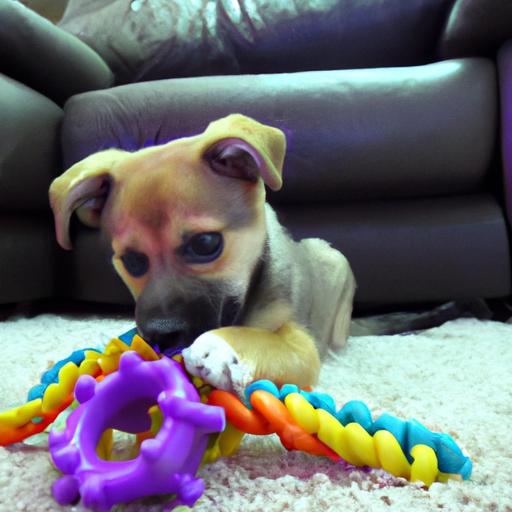Understanding Your Teething Puppy
When your beloved puppy begins teething, it might seem like a challenging phase for both you and them. As a caregiver, you play a significant role in easing their discomfort and preventing destructive behavior.
Teething is a natural process that all puppies go through as they grow their adult teeth. This process usually starts at around 3 weeks old and continues until they’re about 6 months old. During this time, your puppy will experience discomfort and may become more prone to chewing things around the house.
Symptoms of a Teething Puppy
It’s important to recognize the signs of a teething puppy so you can provide the necessary help:
- Increased chewing
- Drooling
- Changes in eating habits
- Swollen or red gums
- Missing teeth
Essential Items for a Teething Puppy
To help your puppy through the teething process, you can provide:
- Chew Toys: These are specifically designed to soothe the irritated gums of a teething puppy.
- Cold Treats: Frozen carrots or specially made puppy teething treats can provide relief.
- Puppy Teething Gel: This can be applied to the gums for immediate relief.
How to Choose the Right Chew Toys
When choosing chew toys, consider these factors:
- Size: It should be big enough that your puppy can’t swallow it but small enough for them to comfortably chew.
- Material: It should be durable and safe for your puppy. Avoid toys with small parts that can be easily swallowed or choked on.
- Texture: A variety of textures will keep your puppy interested and provide different levels of relief.
The following table outlines some recommended chew toys and their attributes:
| Toy Name | Material | Size | Texture |
|---|---|---|---|
| Kong Puppy Toy | Rubber | Small-Medium-Large | Soft but Durable |
| Nylabone Puppy Chew | Plastic | Small-Medium | Hard |
| Benebone Bacon Flavored Wishbone Chew Toy | Nylon | Medium | Hard |
Training Your Puppy During Teething
During this time, your puppy might try to chew on anything they can get their paws on. Here are some tips on redirecting their chewing:
- Puppy-Proof Your House: Move anything you don’t want chewed out of their reach.
- Redirect Their Chewing: If you catch them chewing something they shouldn’t, provide a chew toy instead.
- Positive Reinforcement: When they chew on their toys, praise them or provide a treat.
How to Soothe a Teething Puppy’s Gums
There are several ways you can help soothe your puppy’s gums:
- Cold Items: Just like with human babies, cold items can provide relief. Consider freezing their chew toys or providing frozen treats.
- Gentle Massage: With your clean finger, you can gently massage their gums.
- Puppy Teething Gel: If your puppy seems particularly uncomfortable, this product can provide immediate relief.
When to See a Vet
While teething is a natural process, there are some scenarios where you should consult a vet:
- Your puppy seems excessively in pain.
- There are broken or cracked teeth.
- The teeth are growing in abnormally.
FAQs
Q: What age do puppies start teething?
A: Puppies generally start teething around 3 weeks old.
Q: How long does the teething phase last?
A: The teething process usually ends around 6 months.
Q: Can teething cause my puppy to lose appetite?
A: Yes, the discomfort can cause changes in eating habits.
Q: What can I give my puppy for teething pain?
A: Chew toys, cold treats, gentle gum massages, and puppy teething gel can all help alleviate the discomfort.
Q: What if my puppy swallows a piece of a chew toy?
A: If your puppy swallows a small piece, they might be able to pass it. However, if they seem uncomfortable or the piece was large, it’s best to see a vet.
Teething can be a challenging time for your puppy, but with your care and understanding, they will get through it. Remember, this phase won’t last forever, and soon your puppy will have a full set of strong adult teeth.



